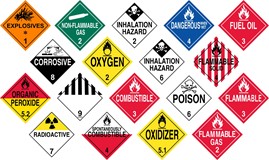November is the Time to Winterize Your Hazardous Waste Management
November 16, 2021
As wintertime bears upon us, depending on how you count, there are three potent reasons why you should move your hazardous-waste disposal drums and containers into the great indoors or—better yet—offsite to get them out of the elements.
Don’t hoard hazmat—get it offsite
As we reminded you in our last post, if you’re a CESQG, the EPA allows you to accumulate hazardous waste onsite for only a short period of time, otherwise you need a TSDF permit.
If you have hazmat barrels languishing onsite next year, a sudden swell in hazmat volume—whether for good or bad reasons—can push you over the limit (or “promote” you from a VSQG to an SQG, or from an SQG to an LQG).
Also consider, while the waste is on your site, you’re responsible for its hazardous waste management, which includes safe storage, safe treatment, accident prevention, and emergency response—all in accordance with federal, state, and local regulations.
In sum, you should get rid of the stuff. And you can get help here to do so.
DOT requirements: When preparing containers for hazardous waste disposal, remember that there are specific DOT requirements for shipping your chemical hazardous-waste offsite for disposal, storage, or treatment.
Not only must the container be clearly labeled as hazmat, it must also prominently display this notice: HAZARDOUS WASTE—Federal Law Prohibits Improper Disposal. If found, contact the nearest police or public safety authority or the U.S. Environmental Protection Agency.
Additionally, the container must clearly show your company’s name, EPA identification number, and manifest tracking number; and there might be additional requirements for bulk-packaging containers.
Labeling must be durable, clearly visible, and written in English. It must be displayed on a contrasting color background and not be obscured by other labels, attachments, or advertising.
Also bear in mind that labeling requirements differ depending on the amount of chemical hazardous-waste you generate. In this regard, the EPA specifies two categories: bulk-packaging and non-bulk packaging.
Loosely speaking, non-bulk packaging dictates a maximum capacity of 119 gal. for a liquid waste (450 L); a maximum of 882 lbs. for a solid waste (400 kg); or a water capacity of 1000 lbs. for a gaseous waste (454 kg). Thereby, bulk-packaging is anything that exceeds these quantities.
Labeling vs. marking: For DOT purposes, the word “labeling” is a very specific thing and is applicable only to bulk-packaging. “Labels” are always diamond-shape; and their size must adhere to international standards, measuring at least 4″ x 4″ (100 mm) on each side, square-on-point. Everything else (applicable to non-bulk packaging) is merely “marking.”

The DOT uses nine categorical hazardous waste disposal labels:
- Explosives
- Compressed gas
- Flammable & combustible liquid
- Flammable & reactive solids
- Oxidizers & organic peroxides
- Poisonous materials & infectious substances
- Radioactive materials
- Corrosives
- Miscellaneous
Need more info about labeling and marking? Get expert advice.
Don’t bet against the winter
If you’re not going to transport your hazmat offsite by winter, then get it indoors.
You don’t even want to think about a hazmat drum getting knocked over by some airborne detritus in the winter wind, and its contents leaking. That’s called a hazmat spill. And the EPA takes a very dim view of those. Less dramatically, you don’t want drum- or container-lids blowing open or off.
Also remember that snow can be unpredictably dynamic when plowed, pushing things over there while it’s being plowed over here. Multitudes of cockeyed rural mailboxes attest to this phenomenon in the springtime, all of them conspicuously askew as the melting snow recedes. And while cockeyed mailboxes are one thing, cockeyed hazmat drums are quite another.
Consider human nature
There’s also the human factor vis-à-vis Old Man Winter. Temptations become manifold and diligence wanes when the weather gets nasty. For example:
- Frigid air can encourage people to just toss something down the drain or into your general waste stream instead of trekking outside to put it where it belongs.
- Or an employee might not adequately batten down or otherwise secure container lids in his or her understandable rush to get in-and-out of the harsh elements.
- Snow can block access to hazmat drums, further discouraging good hazardous waste disposal practices.
So getting your hazmat drums indoors ups the chances for employee compliance.
The upshot
You’re responsible for the safe storage, safe treatment, accident prevention, and emergency response relative to any hazmat stored on your site, all in accordance with federal, state, and local regulations. Meanwhile, the capacity, weather, and human-factor challenges that are endemic to safe & legal hazardous waste management become more acute as the weather worsens.
Why take chances? Get your hazmat offsite or indoors now. You can get help doing so here. Or call 888.681.8923.
And thank you for reading our blog!

